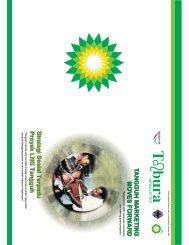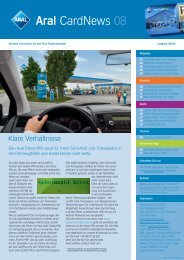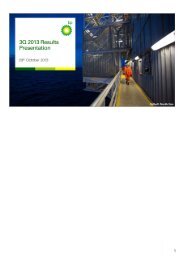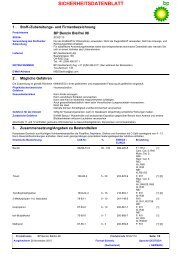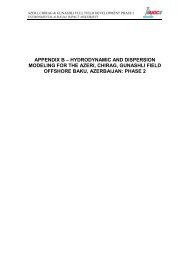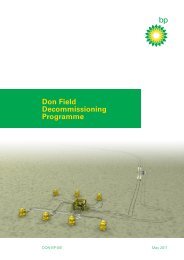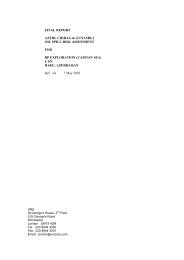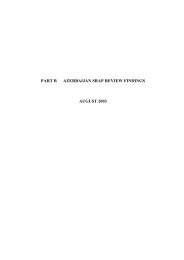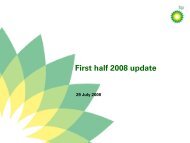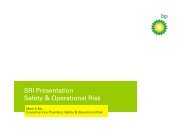BP in Angola Sustainability Report 2010 (pdf, 3860KB)
BP in Angola Sustainability Report 2010 (pdf, 3860KB)
BP in Angola Sustainability Report 2010 (pdf, 3860KB)
Create successful ePaper yourself
Turn your PDF publications into a flip-book with our unique Google optimized e-Paper software.
<strong>BP</strong> <strong>Angola</strong>’s pr<strong>in</strong>cipal operations are<br />
located offshore, more than 100 kilometres<br />
from any centres of population. The<br />
predictive models we used dur<strong>in</strong>g the project<br />
design phase looked at the potential impact<br />
of our operations on air quality onshore. This<br />
analysis found that the operations do not<br />
have any significant impact on air quality on<br />
the <strong>Angola</strong>n coast.<br />
Waste management<br />
We manage our waste through operational<br />
controls, sett<strong>in</strong>g objectives and targets,<br />
monitor<strong>in</strong>g and audit<strong>in</strong>g and conduct<strong>in</strong>g<br />
research or <strong>in</strong>vestigations when necessary.<br />
Our waste management strategy,<br />
implemented through waste management<br />
and handl<strong>in</strong>g plans at a facility level, seeks to<br />
ensure that we meet regulatory requirements<br />
and follow acceptable <strong>in</strong>dustry practices.<br />
We exercise a duty of care over our<br />
waste management practices <strong>in</strong> <strong>Angola</strong> –<br />
us<strong>in</strong>g waste transfer notices to document the<br />
movement of waste from generation through<br />
transfer and handl<strong>in</strong>g by approved contractors,<br />
through to disposal.<br />
We endeavour to implement the waste<br />
hierarchy of reduc<strong>in</strong>g, re-us<strong>in</strong>g and recycl<strong>in</strong>g<br />
waste from our operations <strong>in</strong> <strong>Angola</strong>. The<br />
amount of non-hazardous waste disposed<br />
decreased from 1,147 tonnes <strong>in</strong> 2009 to 426<br />
tonnes <strong>in</strong> <strong>2010</strong>, primarily as a result of lower<br />
levels of drill<strong>in</strong>g activity <strong>in</strong> block 31. The<br />
amount of hazardous waste disposed also<br />
decreased <strong>in</strong> <strong>2010</strong>.<br />
Where it is not feasible to implement<br />
waste reduction, <strong>BP</strong> strives to re-use certa<strong>in</strong><br />
waste streams. For example, we are donat<strong>in</strong>g<br />
waste wood from our operations <strong>in</strong> support of<br />
a local community project. Where re-use is<br />
not practical, we aim to recycle wastes. We<br />
regularly exam<strong>in</strong>e the market to f<strong>in</strong>d new<br />
options for scrap metal recycl<strong>in</strong>g.<br />
Water discharges<br />
With<strong>in</strong> <strong>BP</strong> <strong>Angola</strong>, we try to manage our<br />
wastewater discharges so that we do not<br />
adversely impact the quality of the receiv<strong>in</strong>g<br />
waters. The wastewater streams that we<br />
manage <strong>in</strong>clude ballast water, bilge, oncethrough<br />
cool<strong>in</strong>g water discharges and ra<strong>in</strong><br />
water run-off. We also manage produced<br />
water and have the ability to treat and re-<strong>in</strong>ject<br />
it <strong>in</strong>to the oil reservoir for reservoir pressure<br />
support.<br />
We monitor the amount of oil <strong>in</strong><br />
produced water, and set daily and monthly<br />
average targets for reduc<strong>in</strong>g these levels. We<br />
also monitor and report on the number of oil <strong>in</strong><br />
water excursions (def<strong>in</strong>ed as occasions when<br />
we exceed our desired levels for oil <strong>in</strong> water).<br />
We reduced the number of oil <strong>in</strong> water<br />
excursions to 21 <strong>in</strong> <strong>2010</strong>, compared with 48 <strong>in</strong><br />
2009. However, the total volume of produced<br />
water discharged to the sea has <strong>in</strong>creased<br />
s<strong>in</strong>ce 2008.<br />
Losses of primary conta<strong>in</strong>ment and oil spills<br />
There were 15 losses of material from primary<br />
conta<strong>in</strong>ment (LOPC) <strong>in</strong> our activities <strong>in</strong> 2009,<br />
14 of which occurred <strong>in</strong> operations and one<br />
dur<strong>in</strong>g exploration and appraisal activities. Of<br />
these LOPC <strong>in</strong>cidents, the quantity of the<br />
largest oil spill amounted to approximately 208<br />
litres. In each case, we assessed the actual<br />
and potential severity of the loss and<br />
developed actions to prevent reoccurrence.<br />
There were no LOPC <strong>in</strong>cidents <strong>in</strong> <strong>2010</strong>.<br />
Spill preparedness<br />
We have been enhanc<strong>in</strong>g our oil spill<br />
preparedness and response capability follow<strong>in</strong>g<br />
the Gulf of Mexico oil spill. Initiatives have<br />
<strong>in</strong>cluded the development of offshore and<br />
coastal environmental and socio-economic<br />
maps, <strong>in</strong>tegrated <strong>in</strong>to a geographic <strong>in</strong>formation<br />
system (GIS) database, to identify sensitivities<br />
along the <strong>Angola</strong>n coast where there is<br />
potential for oil spill impact. We will be build<strong>in</strong>g<br />
on this work <strong>in</strong> collaboration with the <strong>Angola</strong>n<br />
Committee of Exploration & Production<br />
Association (ACEPA).<br />
We have also updated our oil spill<br />
model<strong>in</strong>g results – exam<strong>in</strong><strong>in</strong>g where oil spilled<br />
offshore might reach land, and how long it<br />
may take to reach the shore.<br />
Noise<br />
To mitigate and avoid negative effects from<br />
noise on mar<strong>in</strong>e fauna, <strong>BP</strong> has implemented<br />
strict noise controls at all its seismic<br />
operations. This <strong>in</strong>cludes hav<strong>in</strong>g mar<strong>in</strong>e<br />
mammal observers on board the sound<br />
source vessels, mak<strong>in</strong>g provision for stopp<strong>in</strong>g<br />
operations when vulnerable fauna are present<br />
<strong>in</strong> the area and <strong>in</strong>troduc<strong>in</strong>g safe operational<br />
practices such as soft starts.<br />
Monitor<strong>in</strong>g and protect<strong>in</strong>g biodiversity<br />
We are collaborat<strong>in</strong>g <strong>in</strong> a research partnership<br />
to improve understand<strong>in</strong>g of the deepwater<br />
environments of <strong>Angola</strong> where exploration<br />
and production is tak<strong>in</strong>g place.<br />
The deep-ocean long-term observatory<br />
Aerial view of Greater Plutonio FPSO<br />
Environment<br />
system project, is an <strong>in</strong>itiative <strong>in</strong>volv<strong>in</strong>g<br />
Sonangol, SSI and representatives from<br />
several <strong>in</strong>ternational universities and scientific<br />
<strong>in</strong>stitutions, <strong>in</strong>clud<strong>in</strong>g the <strong>Angola</strong>n Institute of<br />
Fisheries Research. The project aims to<br />
measure and monitor deep sea biological<br />
communities and oceanographic conditions,<br />
understand the pace of recovery from any<br />
unforeseen impacts and differentiate between<br />
natural and man-made changes. The project<br />
uses two sophisticated monitor<strong>in</strong>g platforms<br />
positioned <strong>in</strong> water depths of some 1,400<br />
metres, serviced by remotely operated<br />
vehicles.<br />
Follow<strong>in</strong>g <strong>in</strong>itial operational challenges <strong>in</strong><br />
which the new technology was bedd<strong>in</strong>g <strong>in</strong>, we<br />
are now receiv<strong>in</strong>g results from the observatory<br />
and are build<strong>in</strong>g a comprehensive data set that<br />
will enable analysis to beg<strong>in</strong>.<br />
<strong>BP</strong> <strong>in</strong> <strong>Angola</strong> Susta<strong>in</strong>ability <strong>Report</strong> <strong>2010</strong> 23




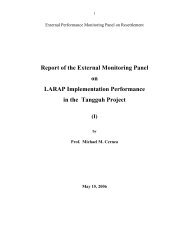
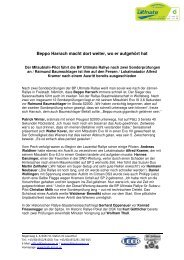
![[PDF] Deepwater Horizon: Accident Investigation Report - BP](https://img.yumpu.com/51697031/1/190x245/pdf-deepwater-horizon-accident-investigation-report-bp.jpg?quality=85)
